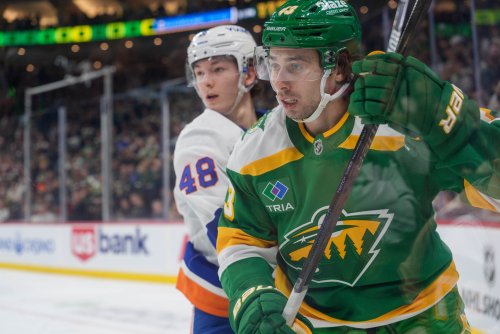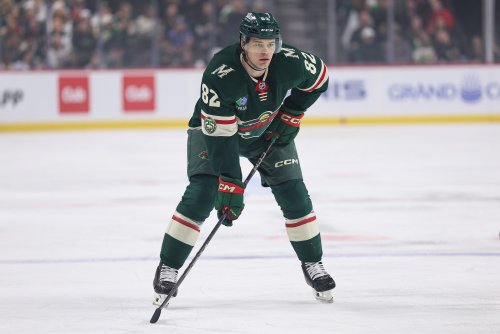.jpg.d8ddfa3fd2e5b5619d60a6c4a38b0996.jpg)
Hockey Wilderness is counting down the Minnesota Wild’s Top-10 Prospects, as voted by our staff. Today, we give you everything you need to know about our No. 5 prospect, Riley Heidt.
Riley Heidt is the Minnesota Wild’s most polarizing prospect.
To rank such a player against other prospects is a mathematical absurdity. It defies logic. It spits in the face of God himself. And yet, we at Hockey Wilderness have concluded that it must be done.
Heidt ranks fifth on our list of Wild prospects.
But what does that really mean? In a literal sense, it means that our writers filled out a ballot ranking their favorite ten prospects. Prospects ranked 1st got ten points, 2nd was worth nine points, etcetera. The point value assigned to Heidt’s ranking was the fifth-most out of any Wild prospect.
In reality, Heidt’s ranking varied wildly from ballot to ballot, more than any other player. He was ranked first on one ballot and ninth on another.

This tracks with public opinion. If ten scouts watched the same game, they could come away with ten different opinions of Heidt. Some love how he dominates junior leagues, while others don’t think he’s big enough to do it against professionals. Some would call his offensive instincts high hockey IQ, while others would criticize his defensive game. On top of that, scouts disagree on whether he shoots and skates at a high level or below an NHL level.
Ever since his draft-year season, Heidt has been a love-him-or-hate-him prospect. Last year, we noted that no prospect had a more polarizing public opinion, according to Prashanth Iyer’s mock draft tracking project. And, despite public mock drafts suggesting a team would take him in the first round, the Wild selected him 64th overall -- the last pick for the second round.
Obviously, that’s good, but how good is it? Well, unless you’ve pored over thousands of seasons of prospects, a quick-and-dirty way to process those point totals is NHL-equivalent points (NHLe). This is an analytical measurement that translates minor-league point totals into NHL point totals based on the difficulty of that league. It also gives extra credit for goals compared to assists because it’s more predictive of NHL success. Byron Bader runs a publicly available model that calculates his version of NHLe at HockeyProspecting.com.

Heidt’s NHLe increased significantly, which is a very nerdy way of being absolutely sure that those increased point totals really mean something. Ideally, prospects increase their NHLe by 20-30% each year; in this case, Heidt’s increased by 26%. That’s an encouraging signal because offensive production is his biggest strength.
However, his detractors don’t seem to have taken much note of this improvement, likely because his downsides are as present as ever. Heidt still has a reputation as an undersized center who doesn’t play bigger than his size. Scouts don’t love his game in the defensive zone, and they predict he’ll need to move to the wing by the time he makes it to the NHL. On top of that, they don’t love that he doesn’t make up for his size with speed.
The Athletic’s Scott Wheeler noted that this reputation followed him to Hockey Canada. “There are mixed opinions on Hockey Canada on Riley Heidt. Even (Team Canada coach) Dave Cameron talked about his inconsistency.” Despite his offensive upside, Corey Pronman also left Heidt outside his top 155 prospects.
So, what is the case against Heidt? Have players with this production failed before? The short answer is yes, but the long answer is more complicated. Looking at players who busted out of the NHL despite similar junior production, there’s reason to suspect that Heidt may not be on the same path.
HockeyProspecting.com lists three players with similar NHLe to Heidt, who played less than 200 NHL games: Bobby Hughes, T.J. Hensick, and Brett McLean. Hughes and Hensick were built similarly to Heidt, but they played nearly 20 years before the Wild drafted Heidt.
At that time, it was much harder to crack the NHL with a smaller build because the league was more physical. Hughes and Hensick weren’t drafted as high as Heidt, which can signal that they were inferior players. MacLean had prototypical NHL size, which may have pressed his draft stock higher.
Ultimately, Heidt isn’t too small to play in the NHL. Plenty of players who were 5’11” at age 18 grow into their frame by the time they play in the NHL. The Wild list Ryan Hartman at 6’0”, meaning he grew into his frame. That’s enough size for him to play center in a middle-six role.
Hartman could be a realistic outcome for Heidt. Hartman overcame his small stature and limited foot speed with high hockey IQ and slick hands. Like Heidt, Hartman has a gnarly edge to his game.
Heidt has a poor defensive reputation, but many scouts note that he’s an enthusiastic and effective forechecker. If Heidt slides to the wing at the NHL level, in-zone defense will become less important. Wingers have a greater focus on the offensive zone, forechecking, and scoring.
Heidt puts all five members of Czechia’s breakout in a pickle above. He times his attacks and spaces himself instinctively to disrupt the breakout. Clearly, Canada has its opponent outmatched across the entire roster. Still, Heidt’s pressure and vision force the Czechs to pass into a 1-on-2 situation, creating a turnover in the neutral zone. That seems to assuage some of the concerns with Heidt’s two-way game.
Heidt plays center in junior hockey, a position that highlights his deficiencies. But he’s likely to shift to the wing when he plays in the NHL. In a vacuum, he would be more valuable at center, but his skills fit more naturally at wing.
Heidt’s potential move to the wing makes it tough for scouts to compliment him without sounding backhanded. They’re forced to criticize his game as it stands or point out that he’ll need to shift to the wing. On our latest episode of Wilderness Talk, Justin Wiggins, Luke Sims, and I discussed that cognitive dissonance. It gets at the crux of why some scouts love him, and others hate him.
If Heidt can stay on his current track, it will give him a realistic future as a third-line winger with the upside of breaking into the top six if he keeps growing his offensive game. The only question is whether he can do it at higher levels. Can his instinctive offense translate when he plays full-grown men, or is he just a junior-league merchant?
There will always be questions until Heidt gets the chance to leave the WHL and play against professionals in the AHL or NHL. Until then, Wild fans can sit back and enjoy the highlights.
Think you could write a story like this? Hockey Wilderness wants you to develop your voice, find an audience, and we'll pay you to do it. Just fill out this form.
-
 2
2
-
 2
2







Recommended Comments
Join the conversation
You can post now and register later. If you have an account, sign in now to post with your account.
Note: Your post will require moderator approval before it will be visible.